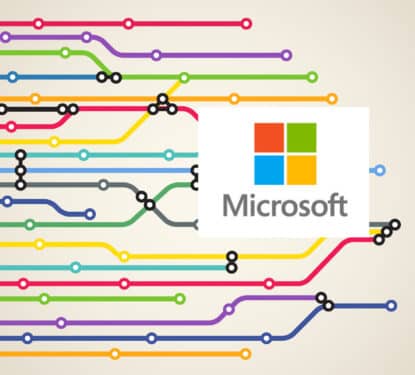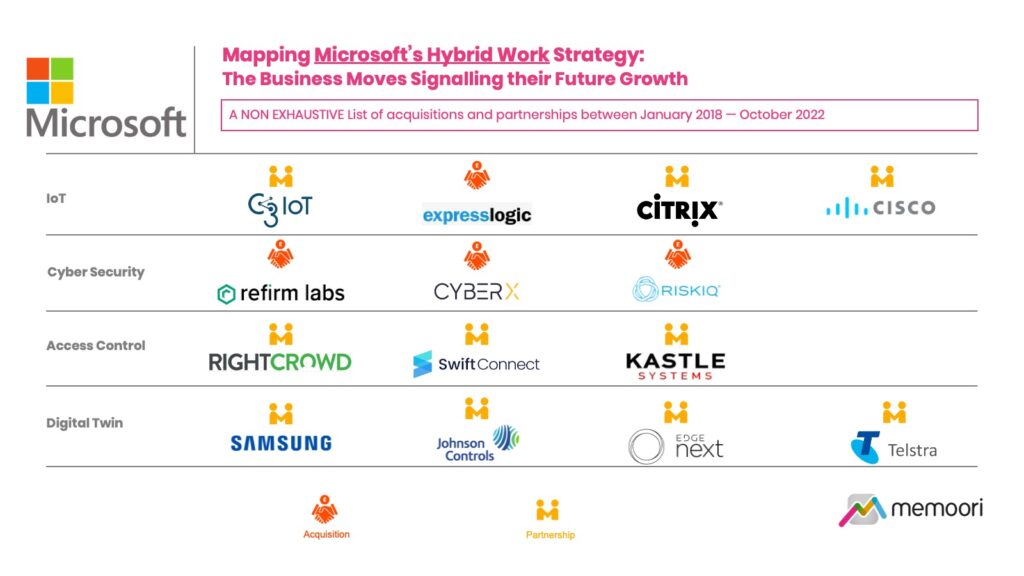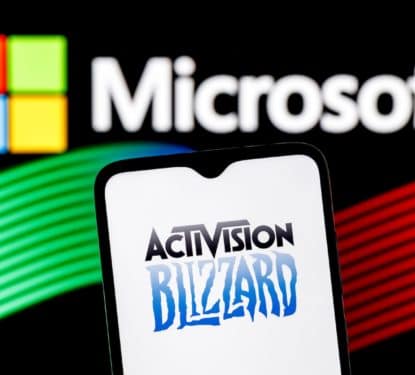"Microsoft"

Mapping Microsoft’s Hybrid Work Business Strategy
In this research note, we map Microsoft’s hybrid work business strategy, analyzing its various partnership and acquisition moves by technology, to trace its course over recent years and explore its intentions for the future.
Microsoft has played a fundamental role in shaping the modern workplace. From its role driving individual computing into the office during the 80s and 90s to its contribution to networking, and on to its current, central position, in contemporary cloud services with the Azure platform.
With the recent launch of Microsoft Places, a workplace platform (available in 2023) for hybrid and in-person work, Microsoft fully intends to use its size and inertia to heavily influence the future of work. The growth of their remote working collaboration tool, Teams, provides a useful benchmark here. Daily active users of Teams grew from 20 million in 2019 to 270 million in 2022! Of course, driven by COVID-induced lockdowns during 2020 and 2021, but also in no small part due to their strategy of product bundling and free distribution. Should Microsoft adopt a similar strategy for Places, it will massively disrupt the current landscape of hybrid workplace software.
Below we have mapped some of the most interesting partnerships with Places and also in the wider PropTech ecosystem. This is a non-exhaustive list. A list of all current Microsoft Connected Workplace partners can be found here.

IoT
The path to the hybrid workplace starts with data collection, both for the enterprises developing their hybrid workforce and the service providers looking to lead the market. Even before the pandemic, Microsoft had been bolstering its smart buildings division with a variety of acquisitions and partnerships in the IoT space, several of these deals are proving critical to Microsoft seizing the growing opportunities in the hybrid workplace.
In 2018, Microsoft announced a strategic partnership with C3 IoT, integrating its low-code, PaaS platform for scaling AI and IoT across enterprises, into Azure. The collaboration enabled customers to rapidly develop and deploy AI-based applications for use cases, such as AI predictive maintenance, dynamic inventory optimization, precision healthcare, and CRM.
A year later, in April 2019, Microsoft announced the acquisition of Express Logic, a specialist in real-time operating systems (RTOS) for IoT and edge devices powered by microcontroller units. At the time of the acquisition, Express Logic’s ThreadX RTOS had over 6.2 billion deployments, making it one of the most deployed RTOS in the world. The deal helped Microsoft unlock access to billions of new connected endpoints and increased the number of devices that can connect to Azure, in the workplace and beyond.
After the pandemic, Microsoft placed greater focus on the workplace and its evolution. In July 2020, the firm announced a partnership with Citrix that sought to reimagine the role of the workplace. Under the partnership, each firm selects each other as preferred services to enable the transition to hybrid work. And, this month, in October 2022, Microsoft partnered with Cisco to bring remote communication to workplace meeting room devices.
Cyber Security
Once on the path to the hybrid workplace, enterprises quickly realize the cyber security challenges. Microsoft is no stranger to cyber security, but the cyber-physical world of buildings and workplaces created new problems that required different skillsets. Consequently, between June 2020 and July 2021, Microsoft acquired three cyber security firms that specialize in IoT networks.
In June 2020, Microsoft announced the acquisition of CyberX for IoT security and threat protection that spans users, endpoints, applications, and data. In June 2021, they announced the acquisition of ReFirm Labs to improve firmware analysis and security capabilities across devices that form the intelligent edge, from servers to IoT. And, in July 2021, Microsoft announced it had acquired RiskIQ, a leader in threat intelligence and attack surface management for cloud, network, and IoT applications.
“Organizations are increasingly using the cloud to reimagine every facet of their business. Hybrid work has accelerated this digital transformation, and customers are challenged with the increasing sophistication and frequency of cyberattacks,” reads the RiskIQ announcement. “As organizations pursue this digital transformation and embrace the concept of Zero Trust, their applications, infrastructure, and IoT are increasingly running across multiple clouds and hybrid cloud environments. Effectively the internet is becoming their new network, and it’s increasingly critical to understand the full scope of their assets to reduce their attack surface.”
Access Control
In 2022, within one week, after the launch of Places, Microsoft announced three partnerships with access control specialists, explicitly stating hybrid work goals with each. On October 12th 2022, the firm announced a partnership with RightCrowd, a global provider of safety, security, and compliance solutions that manages the access and presence of people in dynamic hybrid workplaces.
Two days later, on the 14th, they announced a partnership with SwiftConnect to utilize its platform that provides access control signals for space utilization insights. And three days later, on the 17th, Microsoft announced a partnership with Kastle Systems, a technology provider to the commercial office sector, who will incorporate its open platform for access control data “to help reimagine hybrid work” alongside Microsoft Places.
Digital Twin
While creating the foundation for hybrid work through the IoT, cyber security, and access control data, Microsoft is simultaneously creating the foundation for the smart building through its Azure Digital Twin. The concept behind digital twin technology is to create the ultimate digital platform to support and integrate all smart applications in the building, and Microsoft Azure is well-positioned to be a leader in the emerging market.
To consolidate this position, Microsoft has partnered with a who’s who of tech and automation players; joint research with Samsung seeks to combine smart appliances and digital cloud technologies, a partnership with Johnson Controls to integrate Azure with the OpenBlue building automation platform, and a collaboration with EDGE Next showcases the future of smart and hybrid workplaces.
While regionally specific, Microsoft’s partnership with Telstra, an enterprise telecommunications giant in Australia is noteworthy. Combining the Microsoft Azure suite and cloud services with Telstra’s 5G network and dominant position in Australia’s enterprise market, the pair is building end-to-end digital processes and enabling business models that leverage data to improve decision-making for the workplace and the enterprise.

Playing to Win: Microsoft Joins Facebook in the Metaverse with $69bn Acquisition
Last month, technology giant Microsoft acquired gaming giant Activision Blizzard in a landmark $69 billion deal that represents both Microsoft’s biggest ever acquisition and the biggest deal in the history of the gaming industry….

Microsoft & Iconics Partner on Washington Smart Buildings Project
…Using software developed by Microsoft partner Iconics and MacDonald Miller Facility Solutions; SBETS is based on Microsoft’s cloud and business intelligence platforms. The pilot project will provide King County with…

Microsoft’s Azure Digital Twins Platform Could Disrupt Cloud Computing for the Building IoT
Back in spring this year, Microsoft announced that they intended to invest $5 billion in Internet of Things (IoT) services over the next four years with the goal of “simplifying…

Microsoft & Infosys: The Smart Building’s New Power Couple?
Software stalwart Microsoft announced a new partnership last week with digital services and consulting company Infosys. The deal aims to deliver smart buildings and spaces (SB&S) initiatives for construction, architecture,…

Microsoft Joins the Increasingly Popular Eclipse IoT Foundation
…that is very lightweight and ideal for smart building security and IoT applications. The community continues to grow in 2016. This week at EclipseCon Microsoft announced that they are joining…

Is Microsoft Poised to Disrupt Physical Access Control?
…in many cases. Small installations of 10 to 20 cameras are economically viable, but this for the most part is a very fragmented business. So where does Microsoft fit into…

VC Funding Returns to Smart Building Tech with Investments in Comfy & Aquicore
…on disruptive technology trends. With a formalised venture fund, Microsoft now has a seat at the table”, said Nagraj Kashyap, Corporate Vice President of Microsoft Ventures. Kashyap arrived at Microsoft…
